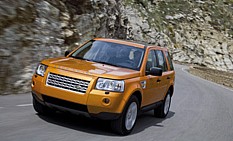Review
CHEVROLET Captiva, Citroën C-Crosser, Honda CR-V, Peugeot 4007 and Vauxhall Antara – off the top of my head, these new mid-size SUVs will all go on sale next year, fuelling a market sector that is already in fast ascent.
But leading the way is the all-new Land Rover Freelander 2, on sale next month and aiming to steal a march on its rivals in this hotly-contested sector.
And it brings many things to the party – great badge, fresh looks, ultra-competent four-wheel drive system, new engines, and much higher prices.
The range now starts at just under £21,000 and rises to nearly £34,000 for the leather-lined HSE petrol. This price hike – the entry-level model costs around £4,000 more than the old version – is explained by the fact that Freelander 2 is only available as a five-door model.
Apparently, the three-door only accounted for a handful of sales and the five-door format is seen as being more premium. Nevertheless, the new five-door-only range is predicted to match Freelander’s annual sales of 20-25,000 units in the UK.
The ‘premium’ word kept cropping up during the launch, leaving us in no doubt that Land Rover sees this model as competing at the upper end of the market, where the BMW X3 lives. It’s a conscious effort from Land Rover to take its smallest model upmarket and the new model’s lines have design cues from its more expensive brothers, the Discovery and Range Rover Sport.
John Edwards, managing director of Land Rover UK, said: ‘Freelander 2 offers the real Land Rover breadth of capability. It’s a true Land Rover in a concentrated package.’
All of which is true. The car is massively over-engineered for what it will need to do.
It is fitted with all of the firm’s trick acronyms – HDC (Hill Descent Control, TR (Terrain Response), ETC (Electronic Traction Control and DSC (Dynamic Stability Control), which combine to make it the most capable small 4x4xfar, as Land Rover’s marketing language goes.
While the majority of owners will never take it far off-road, the car is amazingly competent away from the Tarmac. Land Rover could easily have made this car much more of a soft-roader but, according to the firm, then it wouldn’t be a true Land Rover – they take this off-road lark quite seriously in the Midlands.
; This focus on keeping true to the brand’s virtues is reflected in residual value predictions for the new model. CAP estimates the Freelander 2 will retain between 36% and 45% of its cost new after three years/60,000 miles.
The lower RVs are for the petrols, which will account for as little as 5% of the overall mix. The diesels’ RVs range from 40-45% which, combined with better fuel economy and lower CO2 emissions, make it the only choice for company car drivers. Those RVs will help make monthly rentals more competitive and should open up the Freelander to more user-chooser and opt-out drivers.
Land Rover was rather coy about talking fleet on the launch, although around a third of Freelanders are bought with company money in some way or another and this level will be maintained with the new one.
The TD4 diesel will be the first Freelander 2 to hit the market, on sale from December 7. Powered by the 2.2-litre turbodiesel used in various Ford and Peugeot Citroën Group cars, it comes with a six-speed manual gearbox as standard. An automatic model will follow in the second quarter of 2007.
Also new is the 3.2-litre i6 straight-six petrol engine jointly developed with Volvo (with input to ensure the unit can cope with water wading and rather more extreme tilt angles than a Volvo is used to) and available only with a six-speed automatic gearbox. This unit goes on sale in March.
Behind the wheel
WE may as well get the negative points out of the way first, and there’s only one – the i6 petrol engine allied to the automatic gearbox just doesn’t work in the Freelander. The lack of mid-range torque means the gearbox is always hunting down gears when you press the accelerator and makes for a less than relaxing drive.
On the flip side, the TD4 diesel is excellent and makes such sense from all angles that it’s no surprise it will monopolise sales.
The six-speed manual gearbox has a light shift action while the amount of power available from low down in the rev range makes building and maintaining speed much easier.
On the road, the ride is smooth and refined, while off-road it is amazing. Even badly rutted roads don’t upset things thanks to the excellent suspension damping. Our test route involved some pretty hardcore off-roading, including dune driving, and the Freelander coped with ease.
Inside, quality has moved up several notches in an interior that more closely resembles the larger Discovery 3.
Verdict
BETTER built, stylish to look at and, in diesel form, good to drive – the Freelander has moved the game on hugely. It’s also incredibly competent off road and carries the Land Rover tradition with ease. With strong RVs and more efficient engines, user-choosers should be queueing up to order one.
Fact file
| Model: | i6 petrol | TD4 diesel | ||
| Max power (bhp/rpm): | 233/6,300 | 160/4,000 | ||
| Max torque (lb-ft/rpm): | 234/3,200 | 295/2,000 | ||
| Max speed (mph): | 124 | 112 | ||
| 0-62mph (secs): | 8.4 | 10.9 | ||
| Fuel consumption (mpg): | 25.2 | 37.7 | ||
| On sale: | Dec 7 | |||
| Prices (OTR): | £20,935–£33,990 | |||
| Click on thumbnails for full size image | ||||||
 |
 |
 |
||||
















